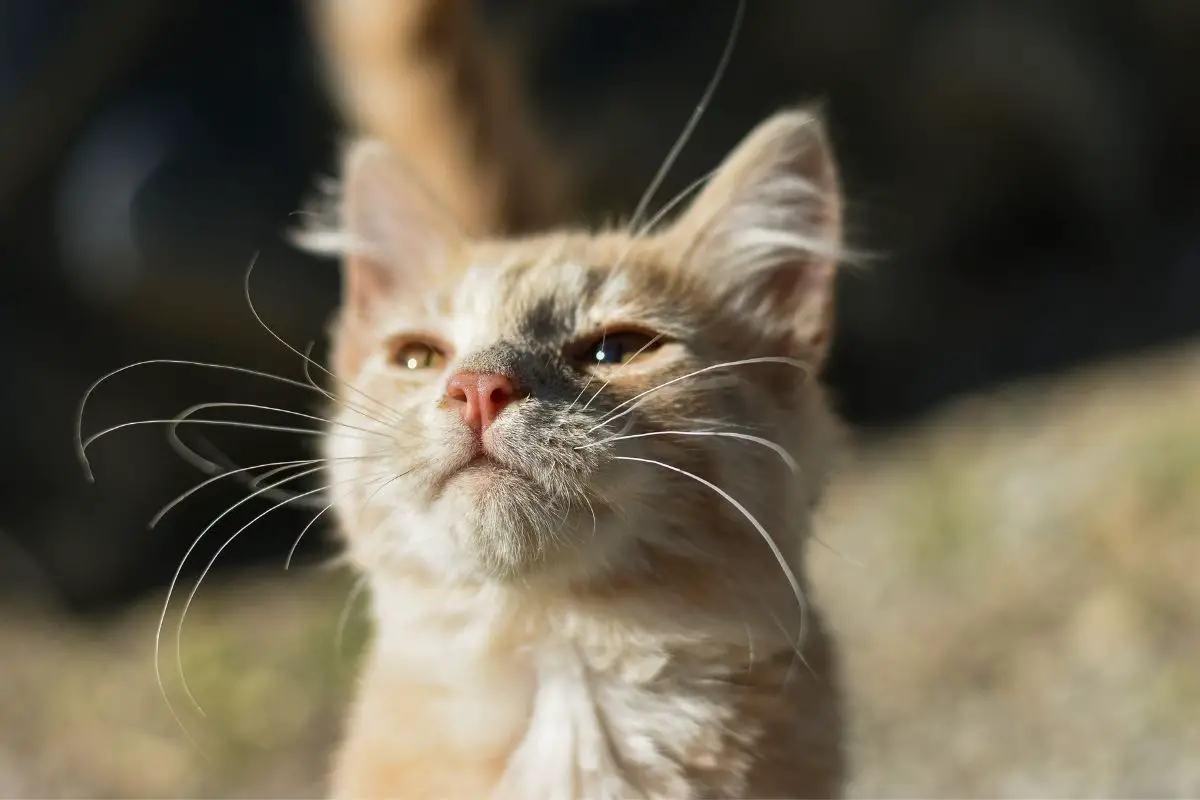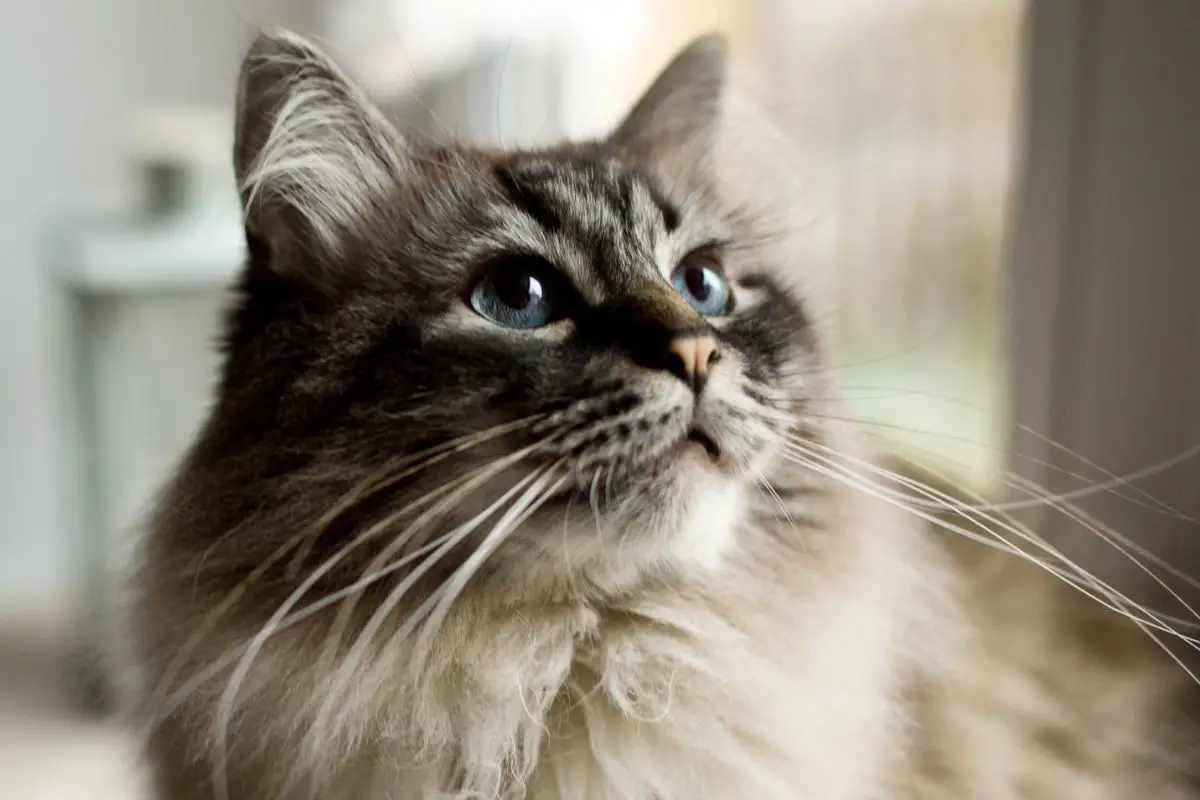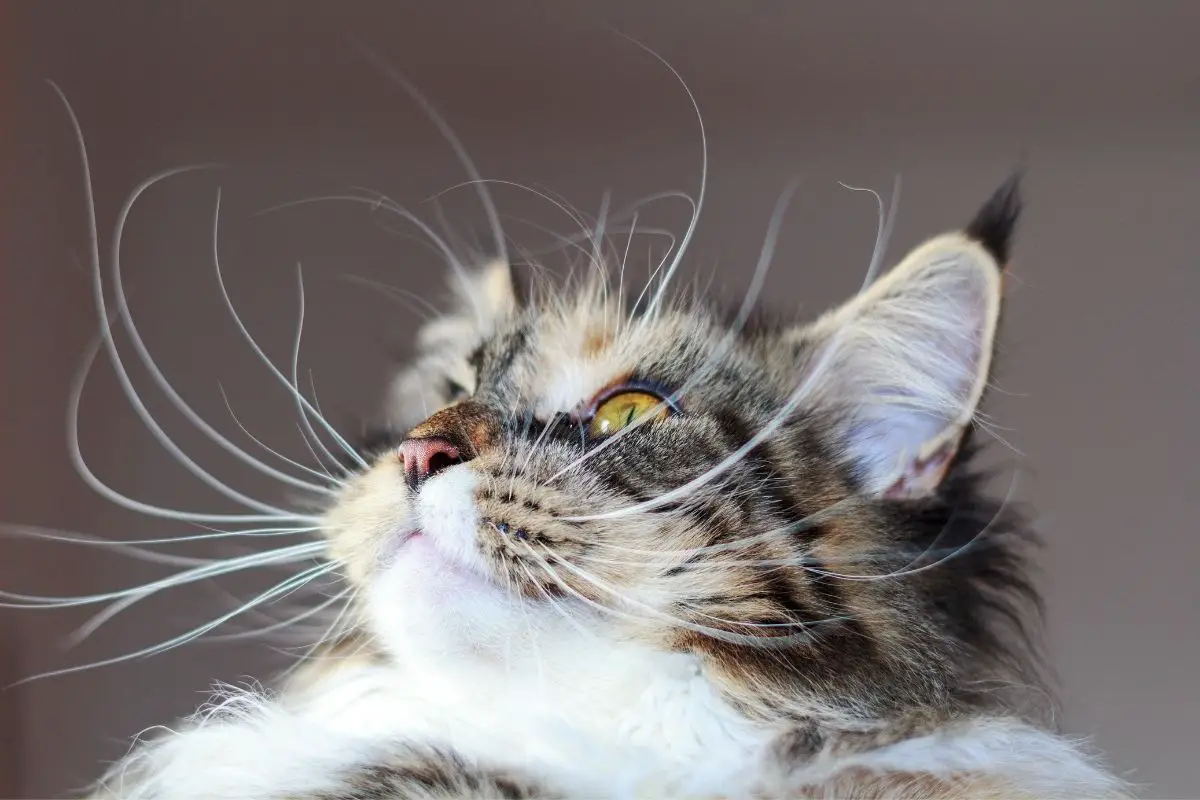Have you ever wondered why cats have whiskers and What Happens If You Cut A Cat’s Whiskers? Though Whiskers help cats to look incredibly cute, they are not just there for aesthetic value.
Well, it turns out that their whiskers are pretty important. With our help, you can find out what the purpose of these stiff hairs is and what will happen if you trim them.
Contents
What Are Whiskers?
Most cats have fur that covers their bodies. Yet, they have another set of hairs that are different from the rest. These are called whiskers.
The whiskers are located on the face and help cats sense movement. Other animals also have whiskers.
In fact, the majority of mammals have whiskers, except for humans. Examples of animals with whiskers include mice, squirrels, and walruses.
Furthermore, some fish and birds even have abilities that are akin to whiskers.
Cat whiskers are found on their cheeks. The positioning and appearance of the whiskers will differ from cat to cat. In general, whiskers are found in different rows.
Most cats have 12 whiskers, though this can vary. Whiskers not only feel different from the rest of a cat’s hair, but they also look different.
For the most part, they are lighter than other hairs. It is common for cats to have white whiskers.
Even if your furry friend does not have white whiskers when they are a kitten, they can become whiter as they age. Despite this, cats can also have whiskers in a wide variety of colors.
Why Do Cats Have Whiskers?
Though they are comparable to a man’s facial hair, whiskers are much more useful.
Cat whiskers are very sensitive, and they play a vital role in helping them navigate through their environment.
These tactile hairs are used as sensors. These whiskers feature nerves, enabling them to act as a sensory organ.
For instance, some cats will use these whiskers to find their food bowl and other nearby objects.
They also help cats communicate with each other. They use this ability to show emotions such as anger or happiness. This is because when cats raise their whiskers, they are showing signs of excitement.
When they lower their whiskers, they mean something else entirely.
In addition, whiskers help cats to detect motion. This is especially helpful when they are hunting prey. It is because whiskers are extremely sensitive that they pick up vibrations.
They will be able to detect when something is approaching due to the air movement. If it has ever felt like your cat has noticed you from afar, it could be due to their whiskers.
How Do Cats Use Whiskers?

Cats use their whiskers by using them to explore their surroundings. They use them to determine whether an object is safe or dangerous.
They can also use them to locate food and water sources. As well as being used to explore their environments, they can also be used to communicate.
In fact, cats can move their whiskers. These whiskers are called mystacial whiskers.
While some animals can only move their whiskers to a limited degree, cats have greater control over their whiskers. This is why they are also used for communication.
After all, what good would whiskers be if you could not move them to communicate different emotions?
By using these whiskers, cats can tell if they can access different areas.
For example, if they are attempting to walk through a narrow gap, a cat can determine whether there is sufficient room for them to pass.
How Do Other Animals Use Whiskers?
The other animals that have whiskers use them for similar purposes. However, they do so in slightly different ways.
Some animals use their whiskers to sense danger. Still, others use them to track their environment.
Among the animals that have whiskers are dogs, beavers, rats, and seals.
You might be surprised by the knowledge that some species of fish have whiskers. These are located near to their mouths. However, they are known as barbels.
One particular species of fish that has whiskers is the catfish.
They were given this name because their whiskers are comparable to those of a cat. Most fish use their barbels to get more food. This is because they contain taste receptors.
The other non-mammal that can have whiskers are birds. While it is not common for birds to have whiskers, some species do use them.
However, these whiskers are very different from those of a cat or other mammal.
These whisker-like features are known as rictal bristles. They are much more similar to feathers.
One variety of bird with particularly strong bristles is the whiskered auklet. This name is an allusion to their whisker-like feathers.
These feathers are believed to have a similar function as cat whiskers, allowing these birds to be aware of their environment even in low light.
Do Big Cats Have Whiskers?
Whiskers play a very important role in our pets’ lives. Though domestic cats have whiskers, you may be wondering whether their relatives, namely big cats, have whiskers.
For those of you unfamiliar with the term, big cats are not just cats that are taller or heavier than the standard cat. Instead, this term refers to different species of large felines.
There are many species of big cats including lions, tigers, and leopards. Though these big cats contrast aesthetically to the average cat, they are actually related. They share many of the same attributes.
One similarity between big cats and the domestic variety is that they both possess whiskers.
It may surprise you to learn that creatures such as lions and cheetahs have whiskers, as they are rarely shown in artistic depictions. However, there are differences.
Unlike the whiskers found on a domestic cat, big cats have longer whiskers. This is because they are proportional to their bodies.
Big cats use their whiskers in the same way that regular cats do. They use them to hunt prey, which is very important for big cats to do.
Thanks to their whiskers, lions and other big cats can sense the movement of prey. Without this aid, big cats may not be able to feed.
As a result, they could die from starvation. One could argue that whiskers are less important for domestic cats since their food is provided for them. Despite this, whiskers remain crucial even for domestic cats.
What Is Whisker Fatigue?

Whisker fatigue is a condition whereby the whiskers are overused.
For example, if your cat’s whiskers have come into contact with a lot of objects, they may experience this. This will have a negative impact on your cat’s attitude, making them feel more anxious. This is because their sensory nerves will be overwhelmed.
If your cat is experiencing whisker fatigue, you should not worry too much. It is not a life-threatening illness.
Despite this, it can have some worrying symptoms that you should keep an eye on. These symptoms often include:
- Reluctance to eat the contents of their food bowl.
- Acting oddly around their food or drink.
- Meowing by their food bowl.
- General irritation.
Normally, whisker fatigue will go away over time. One way that you can promote healing is by changing your cat’s food bowls. There are now whisker-friendly bowls for you to try.
They tend to have sides that are less high, meaning that your cat’s whiskers will not hit the side of the bowl.
For example, you can purchase Dr. Catsby’s Food Bowl. This brilliant bowl is designed to make eating a more pleasurable experience for your pet.
Their whiskers will not get in the way, preventing them from touching the bowl.
This should be enough to cure your cat’s symptoms. After all, you can limit your cat’s irritation with simple lifestyle changes.
On the other hand, if they persist, you may want to take your cat to the vet. They may be able to suggest some simple changes that can help your cat.
Can You Cut A Cat’s Whiskers?
No, you should never try to trim your cat’s whiskers. Doing so could be dangerous to your pet. Cutting a cat’s whisker would cause discomfort.
Moreover, your cat will be unable to experience the benefits of these whiskers. Therefore, they may not be able to hunt other animals that they can eat.
Moreover, it will be harder for them to experience environments. This could lead to injuries.
Moreover, the pet may feel more anxious than normal because their senses will be numbed.
As a result, they might become aggressive towards people. Alternatively, they could be nervous around their owners or anyone else that they come into contact with.
When a cat’s whiskers have been altered, it may be harder to tell what they are feeling. This is because whiskers enable animals to express emotions.
If you have already trimmed your cat’s whiskers, then you should stop what you are doing. Even if your cat’s whiskers look quite long, you should avoid trimming them.
If you do decide to cut your cat’s whiskers, make sure you do it carefully. Trimming whiskers requires skill and patience.
If done incorrectly, it could end up causing your cat a lot of stress. Even if you are careful, we still advise refraining from cutting the whiskers.
If you are certain about shortening the whiskers of your pet, we recommend talking to your vet first. They can inform you of whether it is suitable for your cat’s whiskers to be trimmed.
If a cat needs to have its whiskers trimmed for some reason, your vet will be able to do this in a way that does not irritate your cat.
Unless the trimming is necessary, most vets will warn against cutting your pet’s perfect whiskers.
Frequently Asked Questions
Will Cat Whiskers Grow Back?
Yes, cats’ whiskers grow back after being damaged or trimmed.
If your cat catches their whisker on something and it becomes damaged, you should not panic too much. This is because the hair can eventually grow back.
The length of time it will take for this can vary depending on your cat’s cycle of hair growth. It could take just 6 weeks for your cat’s whiskers to be as good as new. Alternatively, it could take a couple of months.
This is yet another reason to avoid cutting whiskers. Your cat may have to go for a long stretch of time without this sense.
How Long Does It Take To Heal From Whisker Fatigue?
Whisker fatigue usually goes away within a few days. However, there are cases where it takes longer. In such instances, your cat may need to see a veterinarian.
By altering your cat’s eating habits, you can encourage them to recover from whisker fatigue.
Do Cats Enjoy Having Their Whiskers Touched?
Some cats enjoy having their whiskers stroked. When you stroke your cat, they will relax and feel comfortable. This means that they won’t be afraid of you touching them.
On the other hand, other cats do not enjoy having their whiskers stroked.
If you have not tried it before, you may want to try rubbing your cat’s whiskers. If they do not like it, you should stop. If they enjoy it, you can continue to touch their whiskers.
Why Do Some Cats Have Long Whiskers While Others Have Short Ones?
There are many factors that determine how long a cat’s whiskers are. These include genetics, diet, age, and health. Some cats naturally have longer whiskers than others.
Often a cat’s whiskers will match their bodies. This is because whiskers enable cats to determine whether they can fit into certain spaces.
Therefore, if your cat is quite fluffy or fat, they may have long whiskers.
Final Thoughts
Now that you learned What Happens If You Cut A Cat’s Whiskers, its critical to know that Whiskers are important parts of cats’ bodies. They allow them to communicate with each other.
In addition, they also serve as protection against external threats. However, there are times when it is necessary to remove them.
Unless this is the case, you should never trim a cat’s whiskers. This will be painful for them and can result in your cat feeling extremely anxious. Plus, they will lose the additional sense that their whiskers provide.
Consequently, we strongly advise against trimming the whiskers of your cats.



